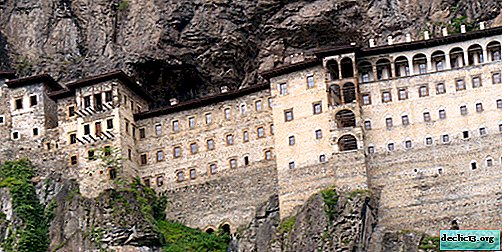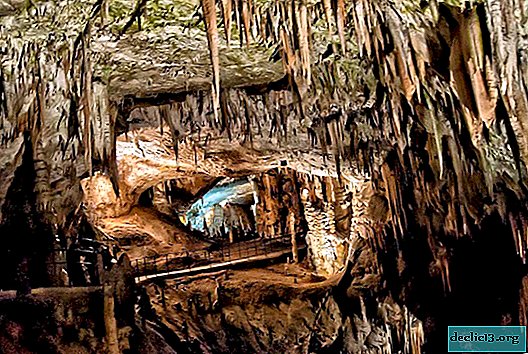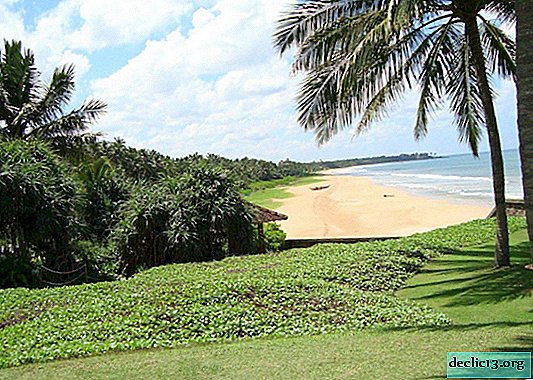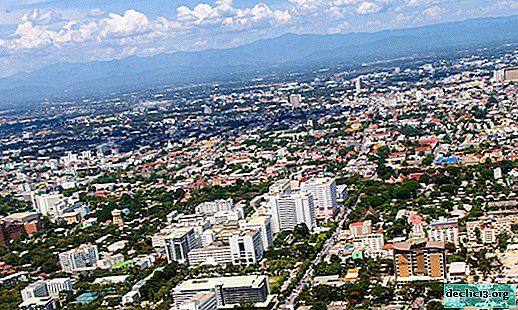Panagia Sumela in Turkey: what helps the miraculous icon
Panagia Sumela is one of the oldest monasteries located in the north-east of Turkey, 48 km from the city of Trabzon. The uniqueness of the complex primarily lies in its centuries-old history dating back over 16 centuries. Of interest is the very method of erecting Panagia Sumela: the structure was carved into the rocks at an altitude of more than 300 m above sea level. In addition, for many centuries the miraculous icon of the Virgin "Hodegetria Sumelskaya" was kept in the walls of the sanctuary, in honor of which the temple was named.

There is a legend claiming that the icon with the face of the Virgin was painted by St. Luke - the patron saint of artists and doctors. It is believed that the apostle has repeatedly witnessed the miraculous healings that Jesus Christ gave to sinners during his earthly life. Saint Luke also wrote one of the Gospels that have survived to this day, and is the first icon painter.
 "Hodegetria Sumelskaya"
"Hodegetria Sumelskaya"If you first hear about the icon of Panagia Sumela and have no idea what they are praying for, then you should know that the prayer of Hodegetria Sumelskaya helps in healing a number of ailments. Especially often women who have problems with conceiving a child turn to her.
Such a monumental structure as Panagia Sumela is of interest not only to Christians, but also to representatives of other beliefs. Some tourists come to the monastery from the resort towns of Turkey, for others, the attraction becomes the main purpose of a trip to the country. And although the interior of the temple is no longer adorned with skillful Byzantine paintings and ornaments, which mercilessly destroyed by time and looters, the building managed to maintain its grandeur and sacred atmosphere.
History reference
After the death of St. Luke, the icon of Panagia Sumela was carefully guarded for a long time by the Greeks, who enclosed the shrine in a church in the city of Thebes. During the reign of Theodosius I, a mother of God from Athens appeared to one clergyman, who called on him and his nephew to devote his life to monasticism. Then, taking the new names Barnavius and Sofronius, at the behest of the Virgin, they went to the temple of Thebes, told the local priests about the revelation that had happened, after which the ministers gave them the icon. Then, together with a miraculous face, they headed east to Mount Mela, where in 386 they built a monastery.

Knowing what the icon of Panagia Sumela helps in and what miraculous healings it shows, the monastery began to be actively visited by pilgrims from European countries before the end of its construction. Despite the great fame and inaccessibility of the church, the Vandals tried to plunder it several times. The largest damage was done to the monastery at the end of the 6th century, when the looters plundered most of the shrines, but the icon of the Virgin still managed to survive. In the middle of the 7th century the monastery was completely restored and numerous pilgrims returned to it.

During the time of the Trebizond Empire (the Greek Orthodox state, formed after the collapse of Byzantium), the monastery of Panagia Sumela experienced its highest prosperity. Between the 13th and 15th centuries each ruler patronized the temple, expanding its possessions and giving it new powers. Even with the arrival of the Ottoman conquerors in the Black Sea region, the monastery of Panagia Sumela received numerous privileges from the Turkish padishahs and was considered almost untouchable. This continued until the beginning of the 20th century.

And after the First World War began, the monks left the monastery, which was later sacked by Turkish vandals. Almost all the murals were destroyed, many of the holy faces were knocked out. But one monk managed to hide the icon: the minister managed to bury it in the ground. Only in 1923 the shrine was dug up and taken to Greece, where it is stored to this day. Today the monastery is not functioning, but it does not stop many guests of Turkey, and they are studying the historical Orthodox complex with great interest.
Monastery structure
Panagia Sumela in Turkey consists of several large and small buildings, among which you can see the Stone Church, a hotel where pilgrims, monastic cells, a library, kitchens and chapels once stayed. On the way to the monastery is a dilapidated fountain, which in the old days stored water from mountain sources. They say that she could heal many ailments.

The center of the monastery was a cave in the rock, once reconstructed as a church. In its external and internal decoration, the remains of frescoes, the basis of which are plots from the Bible, have been preserved. In some chapels, you can also see half-erased images of the Virgin and Christ. Not far from the building is an aqueduct that previously supplied the monastery with water. The structure is formed by numerous arches, which were successfully restored during restoration work.

Vandals could not completely destroy the temple due to the fact that most of the surviving buildings of the monastery are carved in the rocks, and not laid out of stone. Since 2010, at the insistence of the Ecumenical Patriarch, a worship service has been held every year on August 28 in this Turkish monastery in Turkey.
How to get there

The Panagia Sumela Monastery, whose photo clearly demonstrates its greatness, is located in a remote mountainous area in the north-eastern part of Turkey. You can get here in three different ways. The easiest option is to buy a sightseeing tour in the travel agency Trabzon. The agency will provide you with a bus that will take you to the place and take you back. In addition, a guide will accompany you, which will make your visit to the sights more fun and informative. The cost of such a tour starts from 60 TL.

If you want to get to Panagia Sumela on your own, then you need to order a taxi or rent a car. The price of a taxi ride will be at least 150 TL. You can rent an economy car from 145 TL per day. Take the E 97 highway, get to the sign with the Maçka sign and turn into the mountains and follow the parking station. No matter which option you prefer, you will need to walk about 2 km on a steep mountain slope from the parking lot to the temple.
Compare accommodation prices using this form
Practical information

- Address: Altındere Mahallesi, Altındere Vadisi, 61750 Machka / Trabzon, Turkey.
- Opening hours: in the summer season the monastery is open from 09:00 to 19:00, in the winter - from 08:00 to 16:00.
- Admission Cost: 25 TL.
Useful Tips
- Going to this monastery in Turkey, be sure to wear comfortable sports shoes. After all, you have to overcome a distance of 2 km in the mountains.
- Remember to bring water with you. Keep in mind that a cafe is only at the foot of the mountain. It is possible that a few light snacks will not hurt you either.
- Change money for Turkish lira in advance. At the point of interest, currency is accepted at a disadvantageous rate.
- Remember that in the mountains the air temperature is always lower, so when setting off on a trip, be sure to take warm clothes with you.
- Currently, the monastery of Panagia Sumela in Turkey is under repair, which will last until the end of 2019. But the attraction is definitely worth a look at least from afar.


















